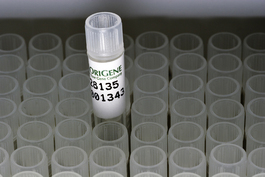TLR4 (NM_003266) Human Untagged Clone
CAT#: SC333282
TLR4 (untagged) - Homo sapiens toll-like receptor 4 (TLR4), transcript variant 3
"NM_003266" in other vectors (2)
Product Images

Other products for "TLR4"
Specifications
| Product Data | |
| Type | Human Untagged Clone |
| Tag | Tag Free |
| Symbol | TLR4 |
| Synonyms | ARMD10; CD284; TLR-4; TOLL |
| Vector | pCMV6 series |
| Sequence Data |
>NCBI ORF sequence for NM_003266, the custom clone sequence may differ by one or more nucleotides
ATGGAGCTGAATTTCTACAAAATCCCCGACAACCTCCCCTTCTCAACCAAGAACCTGGACCTGAGCTTTA ATCCCCTGAGGCATTTAGGCAGCTATAGCTTCTTCAGTTTCCCAGAACTGCAGGTGCTGGATTTATCCAG GTGTGAAATCCAGACAATTGAAGATGGGGCATATCAGAGCCTAAGCCACCTCTCTACCTTAATATTGACA GGAAACCCCATCCAGAGTTTAGCCCTGGGAGCCTTTTCTGGACTATCAAGTTTACAGAAGCTGGTGGCTG TGGAGACAAATCTAGCATCTCTAGAGAACTTCCCCATTGGACATCTCAAAACTTTGAAAGAACTTAATGT GGCTCACAATCTTATCCAATCTTTCAAATTACCTGAGTATTTTTCTAATCTGACCAATCTAGAGCACTTG GACCTTTCCAGCAACAAGATTCAAAGTATTTATTGCACAGACTTGCGGGTTCTACATCAAATGCCCCTAC TCAATCTCTCTTTAGACCTGTCCCTGAACCCTATGAACTTTATCCAACCAGGTGCATTTAAAGAAATTAG GCTTCATAAGCTGACTTTAAGAAATAATTTTGATAGTTTAAATGTAATGAAAACTTGTATTCAAGGTCTG GCTGGTTTAGAAGTCCATCGTTTGGTTCTGGGAGAATTTAGAAATGAAGGAAACTTGGAAAAGTTTGACA AATCTGCTCTAGAGGGCCTGTGCAATTTGACCATTGAAGAATTCCGATTAGCATACTTAGACTACTACCT CGATGATATTATTGACTTATTTAATTGTTTGACAAATGTTTCTTCATTTTCCCTGGTGAGTGTGACTATT GAAAGGGTAAAAGACTTTTCTTATAATTTCGGATGGCAACATTTAGAATTAGTTAACTGTAAATTTGGAC AGTTTCCCACATTGAAACTCAAATCTCTCAAAAGGCTTACTTTCACTTCCAACAAAGGTGGGAATGCTTT TTCAGAAGTTGATCTACCAAGCCTTGAGTTTCTAGATCTCAGTAGAAATGGCTTGAGTTTCAAAGGTTGC TGTTCTCAAAGTGATTTTGGGACAACCAGCCTAAAGTATTTAGATCTGAGCTTCAATGGTGTTATTACCA TGAGTTCAAACTTCTTGGGCTTAGAACAACTAGAACATCTGGATTTCCAGCATTCCAATTTGAAACAAAT GAGTGAGTTTTCAGTATTCCTATCACTCAGAAACCTCATTTACCTTGACATTTCTCATACTCACACCAGA GTTGCTTTCAATGGCATCTTCAATGGCTTGTCCAGTCTCGAAGTCTTGAAAATGGCTGGCAATTCTTTCC AGGAAAACTTCCTTCCAGATATCTTCACAGAGCTGAGAAACTTGACCTTCCTGGACCTCTCTCAGTGTCA ACTGGAGCAGTTGTCTCCAACAGCATTTAACTCACTCTCCAGTCTTCAGGTACTAAATATGAGCCACAAC AACTTCTTTTCATTGGATACGTTTCCTTATAAGTGTCTGAACTCCCTCCAGGTTCTTGATTACAGTCTCA ATCACATAATGACTTCCAAAAAACAGGAACTACAGCATTTTCCAAGTAGTCTAGCTTTCTTAAATCTTAC TCAGAATGACTTTGCTTGTACTTGTGAACACCAGAGTTTCCTGCAATGGATCAAGGACCAGAGGCAGCTC TTGGTGGAAGTTGAACGAATGGAATGTGCAACACCTTCAGATAAGCAGGGCATGCCTGTGCTGAGTTTGA ATATCACCTGTCAGATGAATAAGACCATCATTGGTGTGTCGGTCCTCAGTGTGCTTGTAGTATCTGTTGT AGCAGTTCTGGTCTATAAGTTCTATTTTCACCTGATGCTTCTTGCTGGCTGCATAAAGTATGGTAGAGGT GAAAACATCTATGATGCCTTTGTTATCTACTCAAGCCAGGATGAGGACTGGGTAAGGAATGAGCTAGTAA AGAATTTAGAAGAAGGGGTGCCTCCATTTCAGCTCTGCCTTCACTACAGAGACTTTATTCCCGGTGTGGC CATTGCTGCCAACATCATCCATGAAGGTTTCCATAAAAGCCGAAAGGTGATTGTTGTGGTGTCCCAGCAC TTCATCCAGAGCCGCTGGTGTATCTTTGAATATGAGATTGCTCAGACCTGGCAGTTTCTGAGCAGTCGTG CTGGTATCATCTTCATTGTCCTGCAGAAGGTGGAGAAGACCCTGCTCAGGCAGCAGGTGGAGCTGTACCG CCTTCTCAGCAGGAACACTTACCTGGAGTGGGAGGACAGTGTCCTGGGGCGGCACATCTTCTGGAGACGA CTCAGAAAAGCCCTGCTGGATGGTAAATCATGGAATCCAGAAGGAACAGTGGGTACAGGATGCAATTGGC AGGAAGCAACATCTATCTGA |
| Restriction Sites | SgfI-MluI |
| ACCN | NM_003266 |
| OTI Disclaimer | Due to the inherent nature of this plasmid, standard methods to replicate additional amounts of DNA in E. coli are highly likely to result in mutations and/or rearrangements. Therefore, OriGene does not guarantee the capability to replicate this plasmid DNA. Additional amounts of DNA can be purchased from OriGene with batch-specific, full-sequence verification at a reduced cost. Please contact our customer care team at custsupport@origene.com or by calling 301.340.3188 option 3 for pricing and delivery. The molecular sequence of this clone aligns with the gene accession number as a point of reference only. However, individual transcript sequences of the same gene can differ through naturally occurring variations (e.g. polymorphisms), each with its own valid existence. This clone is substantially in agreement with the reference, but a complete review of all prevailing variants is recommended prior to use. More info |
| Product Components | The cDNA clone is shipped in a 2-D bar-coded Matrix tube as dried plasmid DNA. The package also includes 100 pmols of both the corresponding 5' and 3' vector primers in separate vials. Every lot of primer is tested to provide clean sequencing of OriGene TrueClones. |
| Reconstitution | 1. Centrifuge at 5,000xg for 5min. 2. Carefully open the tube and add 100ul of sterile water to dissolve the DNA. 3. Close the tube and incubate for 10 minutes at room temperature. 4. Briefly vortex the tube and then do a quick spin (less than 5000xg) to concentrate the liquid at the bottom. 5. Store the suspended plasmid at -20°C. The DNA is stable for at least one year from date of shipping when stored at -20°C. |
| Reference Data | |
| RefSeq | NM_003266.3, NP_003257.1 |
| RefSeq Size | 5781 bp |
| RefSeq ORF | 2400 bp |
| Locus ID | 7099 |
| Cytogenetics | 9q33.1 |
| Domains | TIR, LRRCT, LRR, LRR_TYP, LRR_PS |
| Protein Families | Druggable Genome, Transmembrane |
| Protein Pathways | Pathogenic Escherichia coli infection, Toll-like receptor signaling pathway |
| Gene Summary | 'The protein encoded by this gene is a member of the Toll-like receptor (TLR) family which plays a fundamental role in pathogen recognition and activation of innate immunity. TLRs are highly conserved from Drosophila to humans and share structural and functional similarities. They recognize pathogen-associated molecular patterns that are expressed on infectious agents, and mediate the production of cytokines necessary for the development of effective immunity. The various TLRs exhibit different patterns of expression. In silico studies have found a particularly strong binding of surface TLR4 with the spike protein of severe acute respiratory syndrome coronavirus 2 (SARS-CoV-2), the causative agent of Coronavirus disease-2019 (COVID-19). This receptor has also been implicated in signal transduction events induced by lipopolysaccharide (LPS) found in most gram-negative bacteria. Mutations in this gene have been associated with differences in LPS responsiveness, and with susceptibility to age-related macular degeneration. Multiple transcript variants encoding different isoforms have been found for this gene. [provided by RefSeq, Aug 2020]' Transcript Variant: This variant (3) contains an additional internal exon compared to transcript variant 1. This variant represents translation initiation at a downstream AUG compared to variant 1; the 5'-most initiation codon, as used in variant 1, is associated with a weak Kozak sequence and a truncated ORF that would render the transcript a candidate for nonsense-mediated decay (NMD). Leaky scanning may allow translation initiation at the downstream AUG, which results in an isoform (C) with a shorter N-terminus compared to isoform A. |
Documents
| Product Manuals |
| FAQs |
Resources
{0} Product Review(s)
0 Product Review(s)
Submit review
Be the first one to submit a review
Product Citations
*Delivery time may vary from web posted schedule. Occasional delays may occur due to unforeseen
complexities in the preparation of your product. International customers may expect an additional 1-2 weeks
in shipping.






























































































































































































































































 Germany
Germany
 Japan
Japan
 United Kingdom
United Kingdom
 China
China
